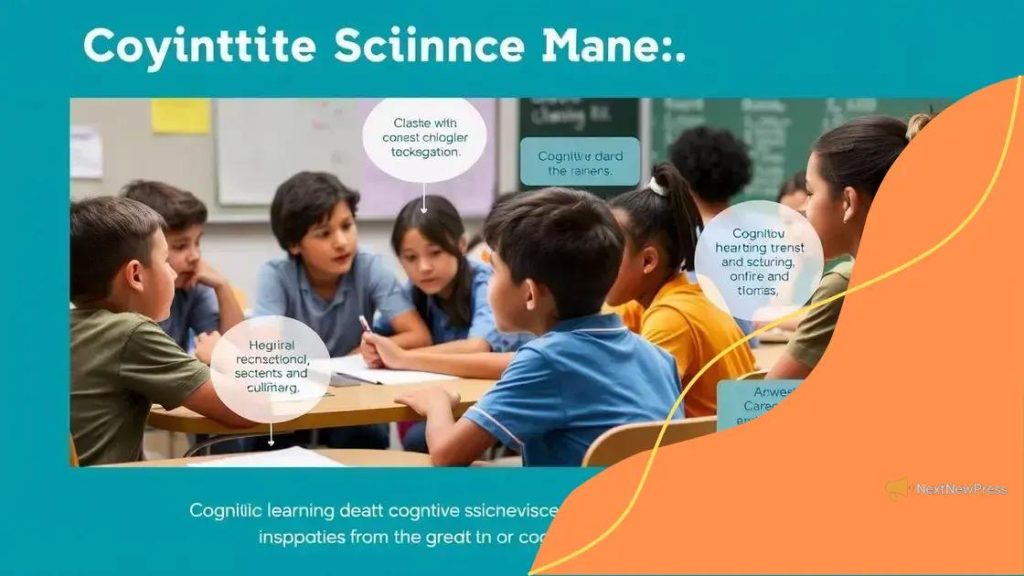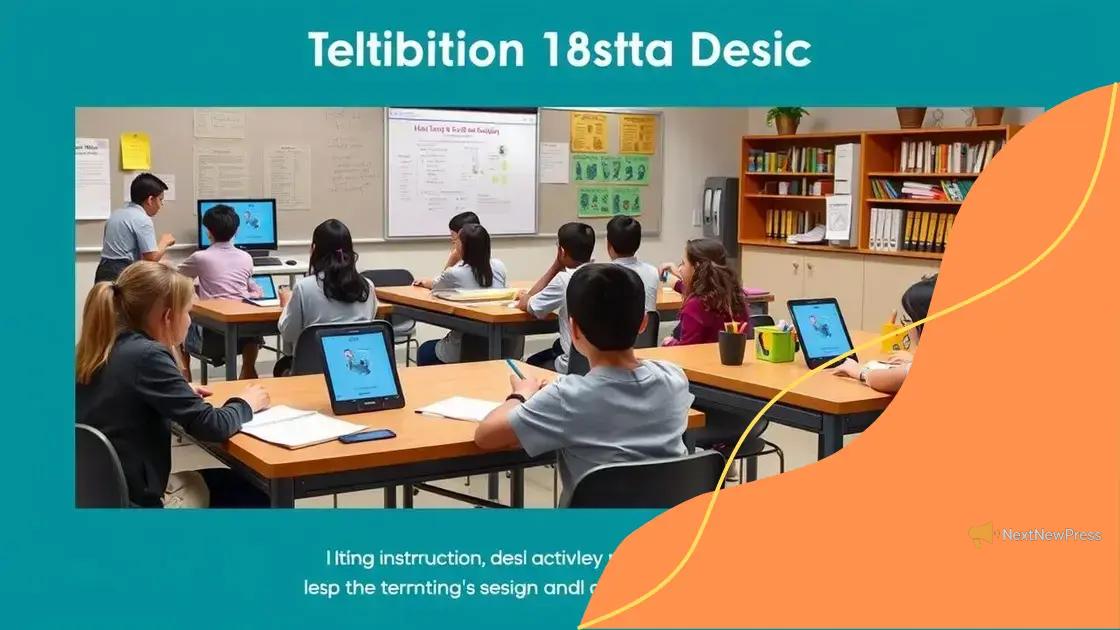Cognitive science in instructional design: unlocking potential

Cognitive science in instructional design enhances learning by applying principles that accommodate diverse learning styles, promote active engagement, and utilize effective assessment methods.
Cognitive science in instructional design offers powerful insights into how we learn and process information. Have you ever wondered how these principles could elevate your teaching strategies? Let’s dive in!
Understanding cognitive science principles
Understanding the core principles of cognitive science is vital for anyone involved in instructional design. This field helps us understand how people learn and retain information, which is essential for creating effective teaching strategies.
One key aspect is memory. Memory plays a crucial role in learning and can be enhanced through various techniques. Educational designers can apply methods that improve retention and recall, making learning more effective.
Key cognitive processes
When we consider learning, we recognize several critical cognitive processes that influence how information is processed:
- Attention: The ability to focus on relevant information.
- Perception: Understanding and interpreting sensory information.
- Reasoning: Making connections and inferences based on what we know.
- Problem-solving: Strategies to overcome challenges using knowledge.
Another important principle is schema, which refers to the mental framework that helps us organize and interpret information. By building strong schemas, learners can integrate new information more effectively with what they already know.
Instructional materials should be designed to support and activate these cognitive processes. For instance, incorporating interactive elements can capture attention, while real-world examples can enhance understanding by connecting new concepts to familiar contexts.
How cognitive frameworks guide learning
Cognitive frameworks also guide how we structure educational content. For example, using the chunking method helps in breaking down complex information into manageable parts. This technique not only facilitates understanding but also aligns with how our brains naturally prefer to process information.
Ultimately, the principles of cognitive science provide a foundation for creating learning environments that promote deeper understanding and engagement. By considering these cognitive aspects, we can develop instructional designs that not only convey information but also inspire creativity and critical thinking.
How cognitive science influences learning
Understanding how cognitive science influences learning is essential for enhancing education. Various theories and principles impact how learners acquire, process, and retain information.
One vital way cognitive science shapes learning is through the concept of active engagement. When students actively participate in their learning process, they tend to retain information better. This approach can include discussions, hands-on activities, and problem-solving tasks.
The role of feedback
Another important aspect is the role of feedback. Timely and constructive feedback helps learners understand their progress and areas needing improvement. Here are some key benefits of effective feedback:
- Encourages reflection: Learners can think critically about their performance.
- Boosts motivation: Positive reinforcement can inspire students to continue improving.
- Clarifies expectations: It helps students understand what is required for success.
Additionally, multimodal learning, which incorporates various forms of media and interaction, can enhance understanding and retention. Using videos, diagrams, and interactive platforms caters to different learning styles, accommodating visual, auditory, and kinesthetic learners.
Cognitive load theory also highlights the importance of managing the amount of information presented to learners at once. When content is overwhelming, it can hinder understanding. By breaking information into smaller, digestible parts, educators can facilitate better learning outcomes.
Bridging theory and practice
Finally, bridging the gap between theory and practice is crucial. Educators must not only understand cognitive principles but also apply them effectively within the classroom. Techniques such as scaffolding, where students are given support that gradually decreases as they become more proficient, can foster independence and confidence.
By leveraging the insights of cognitive science, educators can create environments that enhance learning and engagement. These strategies will ultimately promote better understanding and retention of knowledge among students.
Practical applications in instructional design

Exploring the practical applications of cognitive science in instructional design reveals various strategies that can significantly enhance learning experiences. When designing educational programs and materials, it’s essential to incorporate cognitive principles that facilitate better retention and engagement.
One effective application is the use of learning objectives. Clearly defined goals guide both educators and learners, providing a roadmap for what should be achieved. This clarity helps students focus on key concepts, making the learning process more effective.
Utilizing technology in learning
Integrating technology is another powerful strategy. Tools like learning management systems (LMS) offer interactive features that support different learning styles. These platforms can include quizzes, videos, and forums for discussion, creating a dynamic learning environment.
- Adaptive learning: Technology can tailor educational experiences to individual needs.
- Gamification: Incorporating game-like elements increases motivation and engagement.
- Blended learning: Combining online and in-person education can enhance understanding.
Also, providing scaffolding during instruction helps students build on existing knowledge. This method involves gradually reducing support as learners become more proficient, encouraging independence and confidence in their abilities.
Moreover, employing formative assessments allows educators to gauge understanding throughout the learning process. Frequent evaluation helps identify areas where students may struggle and allows for timely intervention, enhancing overall performance.
Collaborative learning opportunities
Collaboration among students is another effective technique. Group work fosters a sense of community and allows learners to benefit from diverse perspectives. Through discussions and shared tasks, students can deepen their understanding of the material.
Finally, incorporating real-world problems into lessons can also enhance learning. This approach helps students apply theoretical concepts to practical situations, making learning more relevant and meaningful. By bridging theory and practice, students can better grasp the subject matter.
Case studies of successful implementation
Examining case studies can provide valuable insights into how cognitive science has been successfully implemented in instructional design. These real-world examples showcase effective strategies that lead to improved learning outcomes.
One notable case is from a middle school that adopted a project-based learning approach. By allowing students to work on real-world challenges, the school saw an increase in engagement and a boost in critical thinking skills. Students reported feeling more invested in their learning, which led to better academic performance.
University initiatives
At the university level, a prominent institution integrated cognitive science principles into its curriculum design. They focused on active learning techniques, such as group discussions and hands-on projects. This approach resulted in higher retention rates and improved student satisfaction. Students were more likely to retain information when they actively participated in their learning process.
- Flipped classrooms: Instructors provided materials for students to review at home, allowing class time for interactive activities.
- Peer teaching: Students explained concepts to each other, further reinforcing their understanding.
- Diverse assessment methods: Incorporating various forms of assessments helped cater to different learning styles.
An additional example comes from a corporate training program that implemented cognitive strategies to enhance employee learning. The program utilized scaffolding techniques to support new hires, progressively reducing assistance as their skills developed. This approach made employees more confident and capable in their roles.
Moreover, companies that incorporate gamification into training saw an increase in motivation and participation. By adding game-like elements, employees found the training more enjoyable and were more likely to engage fully.
Impacts on retention and engagement
These case studies highlight the significant impact of applying cognitive science in education and training. Organizations that embrace these principles can create learning environments that promote retention, engagement, and practical application of knowledge. As a result, both students and employees can benefit from enhanced learning experiences.
Challenges in applying cognitive theories
Understanding the challenges in applying cognitive theories to instructional design is critical for educators and professionals. While these theories offer valuable insights, integrating them into practice can be complex.
One significant challenge is the diversity of learning styles. Each student has a unique approach to learning, which can make it difficult to apply a one-size-fits-all cognitive theory. Educators must adapt their strategies to include various methods, ensuring that all students can benefit from the material.
Training and resources
Another issue is the lack of training and resources available to educators. Many teachers may not feel comfortable implementing cognitive strategies because they lack sufficient knowledge or skills. Ongoing professional development is essential to help them understand and effectively use these theories in their teaching.
- Access to materials: Providing teachers with materials that explain cognitive theories can enhance understanding.
- Collaboration: Encouraging teamwork among educators can share best practices and successful strategies.
- Workshops: Regular workshops focusing on cognitive science can help teachers stay updated.
Moreover, there can be a gap between theory and practice. While cognitive theories provide a framework for understanding learning, translating these ideas into effective teaching methods is often challenging. Many educators struggle to connect theory with their everyday teaching practices.
Additionally, measuring the success of implementing cognitive theories can be difficult. Assessments may not always capture the nuances of cognitive development, making it hard to determine if the strategies are effective.
Time constraints
Time constraints can also hinder effective implementation. Educators often juggle multiple responsibilities, leaving little time to explore and apply new cognitive strategies. This can lead to a reluctance to try new methods or incorporate additional training into their routines.
By recognizing and addressing these challenges, educators can create more effective instructional designs that incorporate cognitive science principles. Understanding the barriers is the first step toward creating solutions that enhance learning outcomes for all students.
In conclusion, applying cognitive science principles to instructional design can greatly enhance learning experiences. Despite challenges such as differing learning styles, lack of training, and time constraints, the benefits are significant. Real-world applications show that when educators embrace these strategies, students become more engaged and successful. By focusing on continuous improvement and collaboration, we can create effective learning environments that address the diverse needs of all learners.
FAQ – Frequently Asked Questions about Cognitive Science in Instructional Design
What are cognitive science principles?
Cognitive science principles are theories that explain how people learn, remember, and process information, guiding effective instructional design.
How can I address different learning styles in my classroom?
You can address different learning styles by incorporating a variety of activities, such as group work, hands-on projects, and multimedia resources.
What are some challenges in applying cognitive theories?
Challenges include diverse learning styles, lack of training, time constraints, and measuring the effectiveness of cognitive strategies.
Why is ongoing training important for educators?
Ongoing training equips educators with the knowledge and skills to effectively implement cognitive strategies in their teaching.





